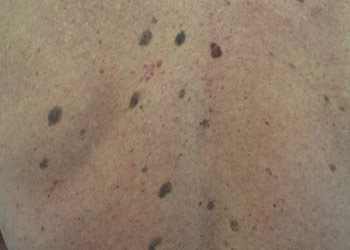


Melanoma is the fourth most commonly diagnosed cancer in Australia and it is the deadliest form of skin cancer.
The World Health Organisation (2010) claims that the role of cumulative sun exposure in the development of malignant melanoma is unclear. However, malignant melanoma risk is higher in people with a history of non-melanoma skin cancers and of solar keratosis, both of which are indicators of cumulative UV exposure.
1 in 17 males will be diagnosed with melanoma and around 1 in 23 women will be diagnosed too. Around 3000 of Australians and New Zealanders will succumb to melanoma each year.
Melanoma will only stay on the surface of the skin for a short period-of-time before it begins to spread. Predominantly, it is a burrower and will grow deep into the skin. It is only a matter of time until the melanoma reaches the blood vessels or lymphatic drainage vessels where cells can break away and be swept away into the body. Once they do this, it can almost be impossible to detect.
How to detect if something on your skin is a melanoma
The shortest time it takes to develop a melanoma is one month.
Here are signs of suspicious symptoms to compare them to.
Treatment
For a new melanoma, surgery is crucial. It is a standard practice in melanoma that along with the tumour, a large area of skin surrounding it must be taken as well. This is a called a margin.
If it is seen that some melanoma cells have found their way a little deeper into the skin, and might have infiltrated into blood or lymphatic vessels, then further tests and surgery may be required to remove lymph nodes that your lymphatic vessels empty to.
Regular skin cancer checks are very important to all Australians. If you have ever had a melanoma, it is imperative that you be thoroughly examined on a very regularly basis to rule out recurrences. Depending on the grade of melanoma diagnosed by your GP, your follow-up visits can range from three monthly to annually.
Warning: Some melanoma and other skin cancers can spontaneously arise on parts of your body not exposed to the sun including between the toes, under the nails, or on the foot. Sometimes they may occur on the eye or even around the genital area. Make sure you check these parts of your body!

For more essential information on skin cancer and UVR, purchase a copy of Karen M. Ong’s International Best Seller ‘The Number 1 Guide to Preventing Skin Cancer; Proven Advice from an Expert.’





